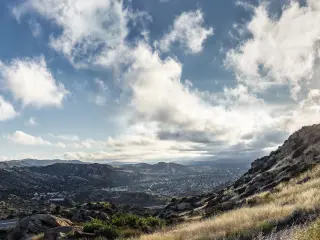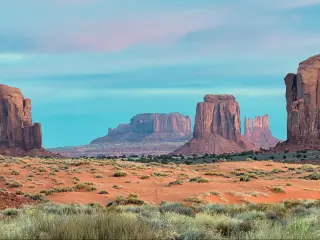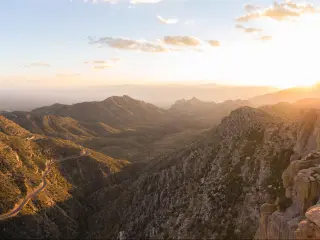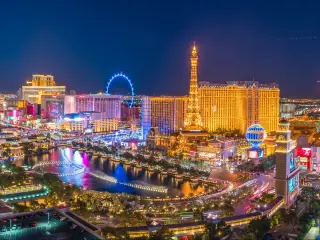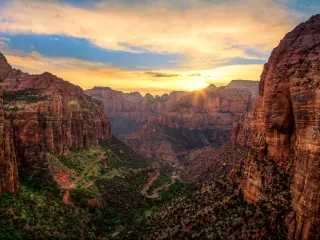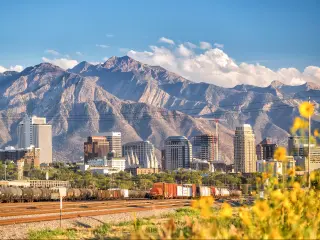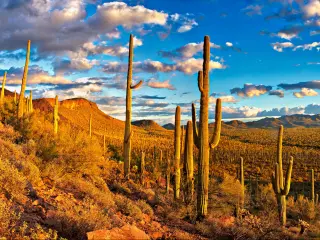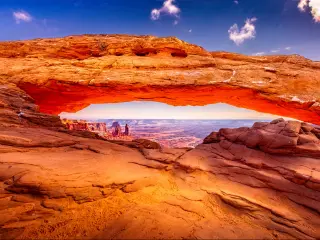Bryce Canyon vs Zion National Park: which is better to visit?
Utah is on the shortlist for many adventurers, being home to the “Mighty Five” national parks, famous for their unique sandstone formations. In this article, we'll fill you in on all you need to know about two of these five fabulous national parks – Zion and Bryce Canyon – both located in the southwestern corner of the Beehive State.
In this side-by-side comparison of Zion National Park vs Bryce Canyon National Park we'll illustrate which park is the best for mountain biking in the backcountry, climbing craggy cliffs, getting that epic sunset pic and hiking through gorgeous terrain.
Read on below to discover the best places to stay, how to get there, what you can expect to see at each park, and if it is really possible to visit both of these national parks on the same trip.
Bryce Canyon or Zion: which national park should you visit?
Decisions, decisions. . . Before we look into particular aspects of Zion and Bryce Canyon, let's go over a brief introduction to each park.
Towering sandstone cliffs, like Angel's Landing, set against gentle greenery and winding, narrow canyons reminiscent of a Dr. Seuss book are just a few of Zion National Park's signature features.
The echo of the Virgin River, choruses of birdsong, and oasis-like fertility of the canyon floor have given sanctuary and rejuvenation to people for thousands of years, from the original Ancestral Puebloans and Kaibab Paiute inhabitants to today's visitors.

It's likeness to paradise earned it the name “Zion”, which means “city of peace” and was given to the area by Mormon settlers. An early 20th century artist Frederick Dellenbaugh popularized Zion across the country, calling it “A New Valley of Wonders.”
Bryce Canyon National Park is also located in southwestern Utah, about 47 miles northeast of Zion Canyon, as the crow flies. Bryce Canyon is one of those special places in the world that make you feel like you've been transported to another one.
Here the landscape is dominated by the power of hoodoos. This might have you asking, “who do?” and re-enacting your favorite Bowie scene from “The Labyrinth”. Bryce Canyon has the largest concentration of these oddly named, naturally formed spires in the world.
The mesmerizing hoodoos of Bryce Canyon are the result of erosion by wind, water, and frost on the edge of Utah's Paunsaugunt Plateau. Though here the term “canyon” in “Bryce Canyon” is a misnomer; these impressive pinnacles are actually grouped in a series of natural amphitheaters.
The magic of Bryce Canyon lies in its intimate scale; there are only a few dozen miles of trail in the entire park which wind in a maze-like way through the reddish-golden hoodoos.
Here's a useful side-to-side comparison of the national parks:
| Zion National Park | Bryce Canyon National Park | |
|---|---|---|
| Size | 229 square miles | 56 square miles |
| Landscapes | Canyons, deep reds and ochres of the cliffs, sagebrush, evergreen trees, fuchsia cactus blossom, and bursts of wildflowers | Craggy, multi-hued, hoodoos, patches of old bristlecone pines, and pinnacles throughout the park |
| Wildlife | Deer, elk, black bears, bighorn sheep, ringtails, bald eagles, California condors | Deer, elk, black bears, bighorn sheep, Clark's nutcrackers, peregrine falcons |
| Scenic views & overlooks |
|
|
| Value for money | Park entry is $35 per vehicle for seven days | Park entry is $35 per vehicle for seven days |
If you'd like to find out about whether it is possible to visit Zion and Bryce Canyon National Parks in a day, here is our ultimate guide.
Which national park is bigger, Bryce Canyon or Zion National Park?
Neither park is massive by national park standards. Zion can be best described as a mid-sized park, covering 229 square miles. As hinted above, Bryce Canyon is one of the smallest parks in the national park system, covering only 56 square miles.
As the saying goes, bigger isn't always better. So, while Zion is larger than Bryce Canyon, keep in mind what kind of terrain, experiences, and accessibility needs are of greatest concern to you as you weigh the advantages of each park.
Is Bryce Canyon better for the scenery than Zion National Park?
Being in such close geographic proximity, it might come as a surprise that each park has a distinct feeling. After you visit one, you're still in store for some surprises at the other.
Due to the small scale of the Bryce Canyon National Park, you feel a bit like you're wandering through a meticulously created movie set or manifestation of a child's dream about a southwestern landscape. When you're here you just can't shake the feeling that you're in one of the earth's most astounding landscapes.
The craggy, multi-hued, hoodoos are undoubtedly the stars of Bryce Canyon, but they are supported by many other facets of the park. In between them, you'll find patches of bristlecone pines, some of which are over 1,000 years old.
Bryce Canyon is also known for dazzling sunrises and sunsets. There is a figure-eight hike in the park that takes you past a sunrise point and a sunset point, so you'll have a chance to view both in their full glory.
Situated on the edge of a plateau, the overall elevation of Bryce Canyon is higher than Zion. This means from a place like Rainbow Point, about 9,000 feet high, you can get breathtaking views of the surrounding area and distant structures like the Kaibab Plateau, 90 miles away.
After the sun sets over Bryce Canyon, you can behold the incredible night sky here, one of the clearest in the continental US. On a crisp, moonless night, up to 7,500 stars are visible to the naked eye.

Alternatively, Bryce Canyon is one of the best places to do a full moon hike. The wide, clear trail, free from dense foliage overhead, runs like a silver streak between the gently illumined pinnacles throughout the park.
Coming to Zion National Park, it could be argued that Zion offers more variety in terms of landscapes, owing to its larger size and wetter environment within the park.
Zion Canyon is formed by the Virgin River, which flows into Lake Mead in Nevada. In the northwest portion of the park, there is a distinct area called Kolob Canyon which is formed by the Taylor and La Verkin creeks.
While very few people get to see the patient power of water which formed monuments like the Grand Canyon, in Zion you have the opportunity to immerse yourself in the very streams which continue to sculpt the landscape in Zion.
On the incredible hike through the Narrows billowing walls of striated sandstone seem to hang on either side of you like stone curtains.
There is an artists' palate of colors that makes Zion seem like a living painting: deep reds and ochres of the cliffs, sage brush, evergreen trees, fuchsia cactus blossom, and bursts of wildflowers of every hue.
The main hub of Zion National Park is Zion Canyon, located in the southeast corner of the park. It is along this canyon that you'll find some of the park's most outstanding stone monuments, like the Court of the Patriarchs and Temple of Sinawava, as well as the Angel's Landing hike which is hair-raising and breathtaking in equal measures.
Does Bryce Canyon have better wildlife than Zion National Park?
Both parks are home to species of deer, elk, black bears, and bighorn sheep. Some distinct avian inhabitants that you can catch at Bryce Canyon include Clark's nutcrackers and peregrine falcons.

Due to the greater diversity of landscapes within Zion National Park, there's also a greater diversity of plants and animals that make this wilderness their home. If you're lucky you can see smaller mammals like adorable ringtails and soaring predatory birds like bald eagles and even a California condor.
You have the best chance of viewing wildlife at both parks outside of the peak summer season, when animals are less encumbered by so many human visitors.
Where can I take the best photos, Bryce Canyon or Zion National Park?
In Bryce Canyon, places like Fairyland Point, Bryce Amphitheater, Paria View, Farview Point, Sunrise Point, and Sunset Point usually have a healthy crowd of visitors clicking away. Most of them feature signature hoodoos, which also make for some great frame-in-frame pictures.
Along the Southern Scenic Drive in Bryce Canyon there are nine overlooks along the route which are equally photogenic, including Natural Bridge, Rainbow Point, and Ponderosa Canyon. Rest assured, family and followers alike will be asking you “Where is this?!”
Over in Zion, you might even stop to take pictures before you enter the park if you're coming from the southeast along the scenic Zion-Mt. Carmel Highway, though there's no stopping at the viewpoints along the tunnel.
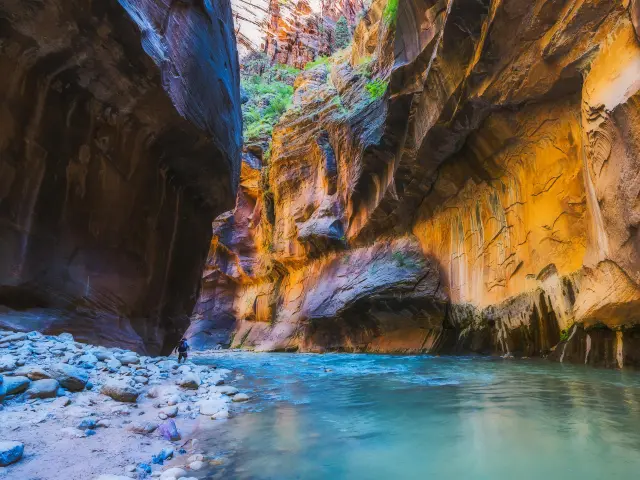
By far the two most photographed features of Zion Canyon are Angel's Landing and the Narrows. The hike up to Angel's Landing leads you up along a thin, spine-like cliff, where there is a sheer drop of over 1,000 feet on either side, up to a slightly wider platform from where you get the most stellar vantage point to capture the wide and lush Zion Canyon down below.
In the Narrows, a hike only occasionally accessible according to the flow of water and flash flood risks, you wade in a tributary of the Virgin River as the canyon walls come closer and closer together. Exquisitely carved sandstone towers over you on each side, making for some unbelievable photos.
Zion National Park also has overlooks like the Big Bend viewpoint, Pine Creek Canyon Overlook, Observation Point, and the Kolob Canyons Overlook, so you can create a robust and varied album of your trip.
In short, both parks are unique and highly photogenic. You'll be tempted to pull out your phone or camera every other step.
Which park is easier to drive around, Bryce Canyon or Zion National Park?
Neither Bryce Canyon nor Zion has an extensive network of roads crisscrossing the park from various directions. Nevertheless, there are gorgeous drives to be had in both parks.
In Bryce Canyon there is one 18-mile-long road that runs through the park along Utah Route 63. It runs from the sole park entrance and Visitor Center to Rainbow Point.
The last 15 miles of this route is called the Southern Scenic Drive and offers nine incredible spots to stop and admire the otherworldly views. Many people suggest leaving for at least 3 hours to cover this out-and-back road.
The Southern Scenic Drive is over 7,500 feet above sea level, its high point reaching 9,000 feet. This entire section after Bryce Point, the mile 3 post, faces winter closures due to icy conditions. Check the park's website for the most current road closure information.
The lifeline of Zion National Park is Zion Canyon Scenic Drive. Due to overcrowding in recent years, the park service operates a shuttle along this road from March to November and completely shuts it to private vehicle traffic. So if you want to make the drive yourself, be sure to plan your visit for the off-season during the winter and early spring.

For a breathtaking drive accessible year-round, look no further than the Zion-Mt. Carmel Highway, on Utah Route 9. It first made motor vehicle access to the park possible in 1930 and was regarded as an engineering marvel at the time.
This road heads to the west from Utah Route 59 and the bottom of Zion Canyon for just over 20 miles to Mt. Carmel Junction and US Route 89.
One hiccup to driving in Zion National Park is the fact that there are no roads within the park which connect the Zion Canyon and Kolob Canyons areas. To reach Kolob Canyon, which has its own entrance and Visitor Center, you have to navigate back to Interstate 15. The perk of this side of the park is far fewer crowds, even during the peak summer months.
Both parks have free parking at their respective visitor centers and at most lookouts along the scenic drives. The Bryce Canyon Visitor Center parking lot has a restriction on vehicles over 20 feet long unless you're parking at your campsite. As each national park is growing in popularity during the peak summer months, expect the parking lots to be full by 10 a.m.
To provide alternatives to traffic and the endless search for parking, both parks have shuttle systems which operate during the summer and make stops in nearby towns. For Zion Canyon, the shuttle stops in Springdale where there are paid lots and for Bryce Canyon you can get on the shuttle before the park entrance at Bryce Canyon City.
Winter closures along its only road limit how much you can drive in Bryce Canyon and summer crowds mean shuttles are your only option for going deeper into Zion Canyon. Still, you can drive the Kolob Canyons area of Zion National Park year-round and the Zion-Mt. Carmel Highway is one of the most scenic roads in the country, ultimately making Zion the more drive-able of the two national parks.
Which park is more expensive, Bryce Canyon or Zion National Park?
Similar to most other national parks, the price for a seven-day pass for a vehicle and all its occupants is $35 at both Bryce Canyon and Zion. An individual seven-day pass for a solo traveler who plans on exclusively exploring the park via the shuttle and on foot is $20 per person.
Annual passes for each park are $70 per vehicle and only allow access to one park. Despite their proximity, there is no dedicated combined pass to cover the entrance fees for both parks.
Especially if you're visiting both parks on the same trip and plan on visiting at least one more national park in the next year, the $80 America the Beautiful annual pass is the most economical way to see these national treasures. It is also a “per vehicle” pass valid for most national parks, so it will cover you if you plan on visiting the parks with different groups of people.
Both parks are in the same rural region of southwestern Utah, so basic food and gas expenses should be similar.
Which national park has better accommodation options, Bryce Canyon or Zion National Park?
Even when you're visiting areas of outstanding natural beauty, where you stay has a big impact on how much you enjoy your trip. Bryce Canyon is more remote than Zion, so the dining and accommodation options are slightly limited, but will still ensure a comfortable stay.
One of the most upscale and convenient places to stay is the Best Western Plus Bryce Canyon Grand Hotel in Bryce Canyon City. It is close to the shuttle stop, so you won't have to worry about the competitive parking within the park. They also have a great pool area and are close to the small collection of restaurants in town.
In case you're making a trip to Bryce Canyon on a tighter budget, consider the Bryce Canyon Resort on Utah Route 12, just before the turn off towards Bryce Canyon. It is about a mile's walk to the shuttle stop and also has a pool in case you'd like refresh yourself with a swim after a day's hiking.
If you're aiming for a more rugged trip, there are two campgrounds in Bryce Canyon: the North Campground and Sunset Campground. The North Canyon is open year-round and only accepts reservations from May 19th through October 7th. The rest of the year, it is first-come, first-serve.
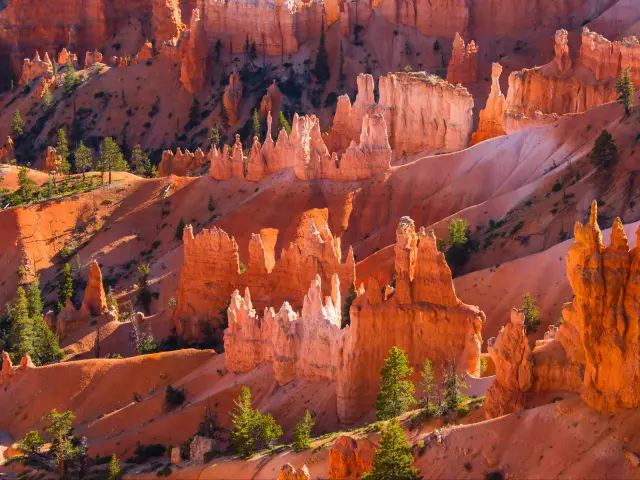
Sunset Campground is first-come, first-served for the entire time it is open from April 15th through October 31st. We highly recommend camping in Bryce Canyon due to the magnificent star gazing and night hiking opportunities to be had here.
Near Zion Canyon National Park there are small towns like Springdale with a wider array of services and amenities.
The simultaneously rustic and luxurious Zion Ponderosa Ranch Resort sits close to the east entrance of the park and its property also backs up to the park border, allowing you to stay surrounded by the same gorgeous scenery you drove all this way to visit.
Another option near Zion is the Hurricane Hideaway Lodging, a simple and well-maintained motel about 24 miles west of the River Entrance to the park in Hurricane, UT.
Zion National Park has three developed campgrounds, all located in the vicinity of Zion Canyon. There are no campgrounds in the Kolob Canyons. Camping is very popular in the park, so be sure to make a reservation through the park website as soon as possible, especially if you plan on coming during the summer.
If you're coming in the winter, then the Watchman Campground is currently your only option as the South Campground undergoes some prolonged maintenance.
As you can see there are fabulous options in and near each national park, whether you prefer a big comfy bed or a night under the stars.
Comparing Bryce Canyon and Zion National Parks by season
You can experience the magic of Bryce Canyon and Zion any time of the year since both parks are open year-round. Due to the higher elevation of Bryce Canyon, it's typically a bit cooler here than in Zion throughout the year.
That said, there's a huge annual variance in the temperature in both parks as well as the crowds, so there are seasonal considerations to make as you plan your trip.
Bryce Canyon vs Zion National Park in spring
Spring is a great time to visit Bryce Canyon, with comfortable weather and slightly fewer crowds than in the summer. It is also considered the rainy season, though there's not so much precipitation to make a visit uncomfortable as long as you bring a light rain jacket.
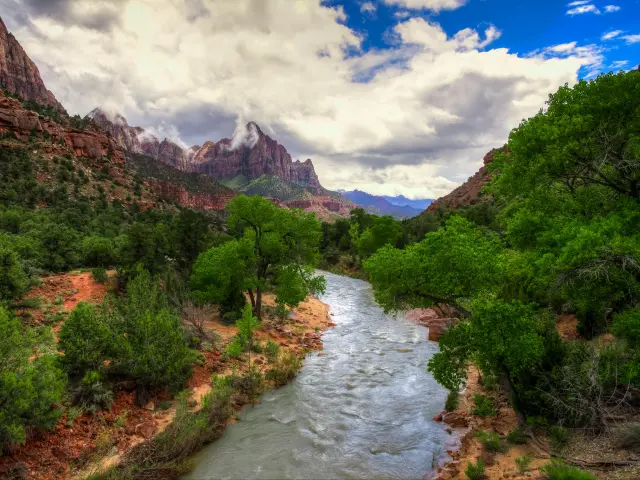
The upside of the spring rains is a short burst of wildflower blossoms. Time your visit right and you could hike Bryce Canyon among red Wyoming paintbrush blooms and white-violet Western irises.
Over in Zion, there is even more vivid color of emerging plant life and wildflowers. Later in the spring, the Virgin River and waterfalls peppered throughout the park also have increased flow. This is a particularly nice season to hike the Emerald Pools Trail.
Even though the number of visitors at Zion sharply increases as the spring warms up there are still corners of the park like Lava Point, Pine Creek, and Kolob Canyons area where you can enjoy more solitary exploration.
Bryce Canyon vs Zion National Park in summer
As with most national parks, the warm weather and school vacations combine to bring droves of people to both Zion and Bryce Canyon in the summer. Crowding in both parks has become such an issue, that the parks have had to introduce summer shuttle systems to move people between popular spots and trailheads in the park. Even parking for the shuttle in Zion gets competitive!

Zion Canyon is typically hotter than Bryce Canyon. During a heat wave temperatures can reach over 90 degrees Fahrenheit in both parks and Zion can see triple digits. In Bryce Canyon, the hoodoos provide some shade along the trails, but typically trails are more exposed than in Zion.
Unlike at Zion Canyon, the water sources which formed the incredible structures of Bryce Canyon have mostly dried up on the surface, so expect a more arid, desert-y feel to this park during the summer.
Summer is the most popular season for the Narrows hike in Zion; be sure to check the latest alerts for flash flood warnings.
Due to the relatively compact size of both parks, during the peak summer season it is hard to avoid the crowds. The only exception to this is the Kolob Canyons region of Zion off Interstate 15.
Be sure to make any booking for hotel rooms or campsites as early as possible if you plan on visiting these parks during the summer.
Bryce Canyon vs Zion National Park in the fall
Fall is one of the best times to visit this part of Utah for the last bits of warm weather before the winter freeze sets in. The temperate weather of early fall is ideal for longer hikes. You can also expect lower rates on accommodation near both parks following the summer rush.
In addition to less crowds, in Zion the cottonwood trees are alight with golden foliage. There are also many clear nights ideal for star gazing in Bryce Canyon.
At the entrance to Zion National Park, in the tiny town of Springdale, they have stated an annual Zion Canyon Music Festival held every September. The festival is still up and coming, but this would be a great time to combine a visit to the park with an upbeat outdoor music experience.
Just be aware that Utah schools have a weeklong break in mid-October when both parks see a spike in visitors.
Bryce Canyon vs Zion National Park in the winter
Winter offers the greatest seasonal variation between Bryce Canyon and Zion. Bryce Canyon gets much colder, much earlier in the winter than Zion. If you're in Bryce Canyon during December or January there's a good chance, you'll be able to witness the park turned into a winter wonderland by a dusting of snow.
If you were planning on camping, the bottom of Zion Canyon rarely if ever sees snow, but after sundown freezing temperatures are found in both parks, so bring a thick ground pad and many extra layers.
As we said above, Bryce Canyon becomes less easy to drive through in winter. Additionally, sections of some trails, including part of the popular Rim Trail, can be temporarily closed due to ice. It would be a good idea to bring crampons or hiking poles if you want to get out on the trails of Bryce Canyon on a winter trip.
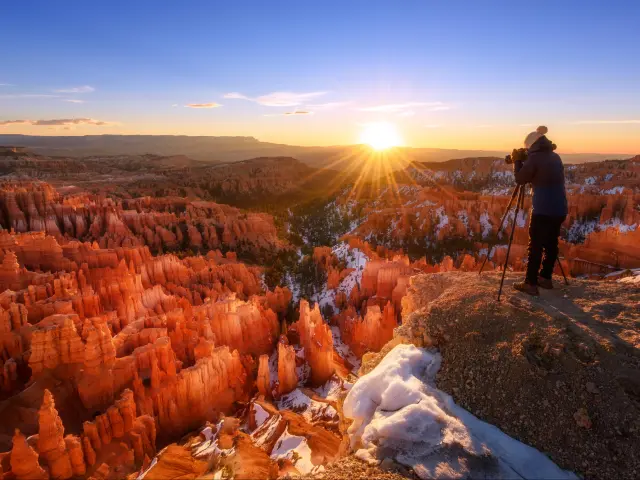
One the other hand, Zion becomes more accessible by road during the winter. This is the only time of the year when the crowds are low enough that the park service lets people drive their own vehicles on the scenic Zion Canyon Road.
During the depths of the winter, the plateaus surrounding Zion Canyon get a dusting of snow that adds to their majesty. With a few extra layers you can explore the lower elevations of Zion without any specialized gear.
Favorite hikes like Angel's Landing can get patches of ice that require a little extra attention. Those who can take the frigid waters and have the right kind of thermals can enjoy one of the best seasons to wade through the Narrows.
If you are into snow shoeing and cross-country skiing, Zion offers chances for these winter sports in the higher elevations of Kolob Terrace Road and Hop Valley.
Even though we've mentioned it before, it is worth emphasizing that Bryce Canyon is an internationally renowned location for observing the night sky. If you fancy yourself an amateur astronomer, then it would be fun to time your visit with a passing comet or rare conjunction of two or more planets.
Planning a road trip to Bryce Canyon or Zion National Park
Bryce Canyon and Zion are practically right next to each other in southwest Utah. They are only 72 miles apart, or a one hour and a half drive. It is very common to do a trip that incorporates both parks.
Zion is slightly closer to major roads like Interstate 15 and US Route 89, making it more accessible, but both Zion and Bryce Canyon have well-maintained roads leading to them. Here is a helpful table highlighting popular road trips to Zion:
If coming via Interstate 15, you could drive a loop, first taking Utah route 143 or 14 East, across US Route 89, to Utah Route 12 and Bryce Canyon National Park. From there, you could navigate back to US Route 89 and head south to Mt. Carmel Junction.
In Mt. Carmel Junction, hop on the gorgeous Utah Route 9, also known as the Zion-Mt. Carmel Highway, and make your way to the East Entrance of Zion National Park. Utah Route 9 also continues west, past the park, back to Interstate 15.
If you're traveling from the southeast via US Route 89, you'll pass by the turn off for Zion before heading towards Bryce Canyon. Check out this table if you are continuing on to Bryce Canyon:
| Starting city | Distance (time) | Highlights |
|---|---|---|
| Las Vegas | 260 miles (4 hours) | Valley of Fire State Park, St. George, Red Cliffs National Conservation Area, Dixie National Forest |
| Salt Lake City | 270 miles (4 hours 10 minutes) | Provo, Mt. Nebo, Mona Reservoir, Yuba State Park, Dixie National Forest, Kolob Canyons |
| Phoenix | 430 miles (7 hours) | Flagstaff, Grand Canyon National Park, Page, Kanab |
| Los Angeles | 530 miles (8 hours) | Mt. San Antonio, San Bernardino National Forest, Baker, Mojave National Preserve, La Vegas, Dixie National Forest |
| San Diego | 595 miles (9 hours) | Los Angeles, San Bernardino National Forest, Baker, Mojave National Preserve, La Vegas, Dixie National Forest |
| San Francisco | 780 miles (12 hours 50 minutes) | Livermore, Sacramento, Tahoe National Forest, Reno, Dixie National Forest |
| Seattle | 1,100 miles (17 hours) | Boise National Forest, Twin Falls, Salt Lake City, Provo |
| Austin | 1,240 miles (19 hours 40 minutes) | Lubbock, Albuquerque, Canyon de Chelly National Monument, Lake Powell, Mt. Carmel |
| Chicago | 1,540 miles (23 hours 50 minutes) | Des Moines, Omaha, Denver, White River National Forest, Moab, Fish Lake Hightop |
A word to the wise is to plan to drive exclusively during daylight hours as many sections of Utah Routes 9 and 12 have no lighting at night, but plenty of nocturnal critters.
If you plan on doing this trip in an RV or with a large trailer, then be aware that the Zion-Mt. Carmel Tunnel has strict vehicle height restrictions and they will turn oversized vehicles away.
In case you're on a tight schedule and really only have time for one of these outstanding national parks, here are some driving distances with the closest park listed to help you choose.
Which national park is the best, Bryce Canyon or Zion National Park?
Each park is strikingly beautiful in its own way and offers geological formations that you'd be hard-pressed to find anywhere else in the world.
Both Bryce Canyon and Zion offer gorgeous hiking, biking, horseback riding, and camping options. Zion has more chances for cross country snow activities in the winter and climbing and canyoneering opportunities in the summer, none of which are possible in Bryce Canyon.
Each park has its own limitations on driving, depending on the season. In Zion you'll be forced to take a shuttle along the scenic canyon route during the summer, but you can drive along it during the other seasons.

In Bryce Canyon, there's only one road which is open to personal vehicles during the summer, but it is almost completely closed due to icy conditions in the winter.
Zion is the more visited of the two parks, meaning increased traffic and people in the peak summer season. Though Bryce Canyon's smaller size makes a smaller crowd more noticeable on the trails.
Zion also has a more diverse landscape that takes a longer time to explore. While you need at least two to three days to really explore and get a sense of Zion National Park, Bryce Canyon is one of the few national parks that you can get a good feel for in a day.
Despite being significantly smaller than Zion, the “wow” factor at Bryce Canyon is undeniable. Park Rangers have said that many visitors exclaim “This is better than the Grand Canyon!” upon their first glance over the bemusing hoodoos.
The rush of adrenaline after you reach Angel's Landing, 1,500 feet above the floor of Zion Canyon and the awe of seeing the milky way splayed out over thousands of hoodoos are really incomparable. So why set up a false choice?
Ultimately we recommend a both/and approach to Zion and Bryce Canyon given their sizes and proximity to one another. Even on a four-day trip, it would be possible to base yourself in or near Zion Canyon and make a day trip to catch a glimpse of Bryce Canyon.
Whatever you plan to include on your road trip, we are sure that this southern tip of Utah will enchant you.
READ MORE - Zion and Bryce Canyon in One Day? The Best Way to See These Awesome National Parks

